Arm Announces Armv9 Architecture: SVE2, Security, and the Next Decade
by Andrei Frumusanu on March 30, 2021 2:00 PM ESTIntroducing the Confidential Compute Architecture
Over the last few years, we’ve seen security, and security breaches of hardware be at the forefront of news, with many vulnerabilities such as Spectre, Meltdown, and all of their sibling side-channel attacks showcasing that there’s a fundamental need for a re-think of how to approach security. One way Arm wants to address this overarching issue is to re-architect how secure applications work with the introduction of the Arm Confidential Compute Architecture.
Before continuing, I want to warn that today’s disclosures are merely high-level explanations of how the new CCA operates, with Arm saying more details on how exactly the new security mechanism works will be unveiled later this summer.
The goal of the CCA is to more from the current software stack situation where applications which are run on a device have to inherently trust the operating system and the hypervisor they are running on. The traditional model of security is built around the fact that the more privileged tiers of software are allowed to and are able to see into the execution of lower tiers, which can be an issue when the OS or the hypervisor is compromised in any way.
CCA introduces a new concept of dynamically creates “realms”, which can be viewed as secured containerised execution environments that are completely opaque to the OS or hypervisor. The hypervisor would still exist, but be solely responsible for scheduling and resource allocation. The realms instead, would be managed by a new entity called the “realm manager”, which is supposed to be a new piece of code roughly 1/10th the size of a hypervisor.
Applications within a realm would be able to “attest” a realm manager in order to determine that it can be trusted, which isn’t possible with say a traditional hypervisor.
Arm didn’t go into more depth of what exactly creates this separation between the realms and the non-secure world of the OS and hypervisors, but it did sound like hardware backed address spaces which cannot interact with each other.
The advantage of the usage of realms is that it vastly reduces the chain of trust of a given application running on a device, with the OS becoming largely transparent to security issues. Mission-critical applications that require supervisory controls would be able to run on any device as say opposed to today’s situation where corporate or businesses require one to use dedicated devices with authorised software stacks.
Not new to v9 but rather introduced with v8.5, MTE or memory tagging extensions are aimed to help with two of the most persistent security issues in the world’s software. Buffers overflows and use-after-free are continuing software design issues that have been part of software design for the past 50 years, and can take years for them to be identified or resolved. MTE is aimed at helping identify such issues by tagging pointers upon allocation and checking upon use.


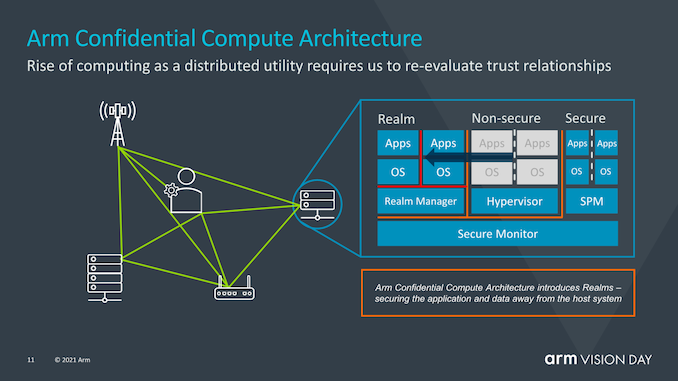
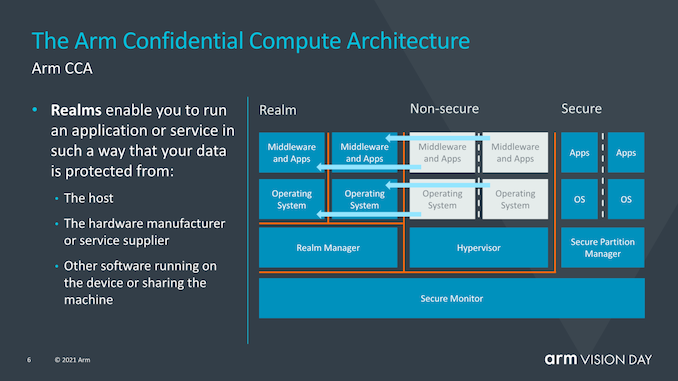
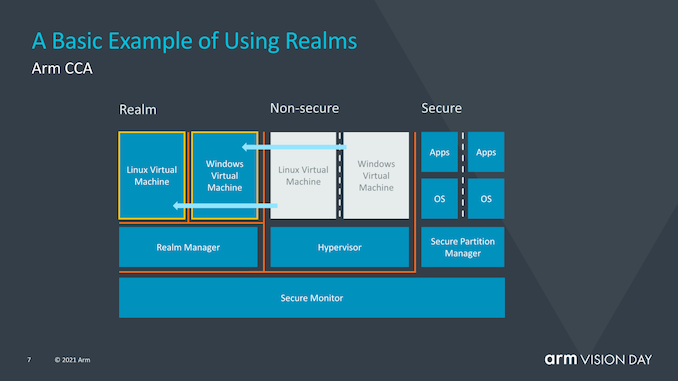
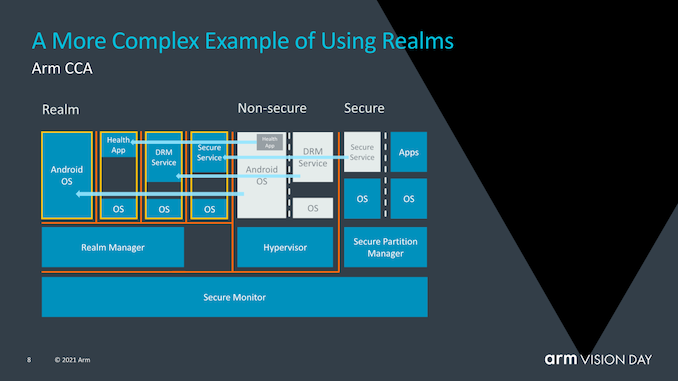

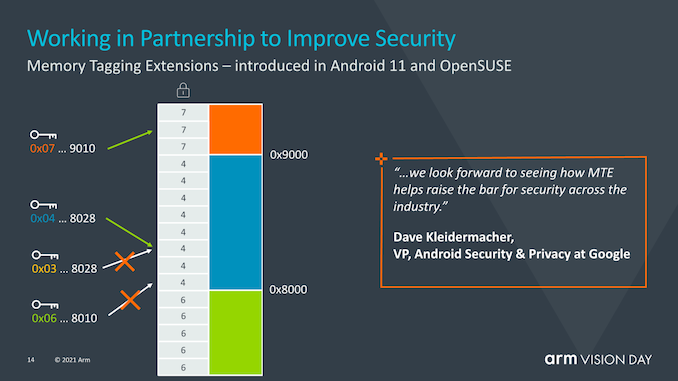








74 Comments
View All Comments
SarahKerrigan - Tuesday, March 30, 2021 - link
Good to see SVE2 in base, though some of the choices being made by software projects around how to implement SVE have seemed a bit grody.CCA looks like TZ-rooted virtualization.
skavi - Tuesday, March 30, 2021 - link
Substantially more grody than typical SIMD? Any open source examples?SarahKerrigan - Tuesday, March 30, 2021 - link
Last time I looked at Eigen, IIRC, it was requiring a width to be specialized at compile-time... which kind of defeats the purpose. I only glanced over it briefly, so maybe I misunderstood.emn13 - Saturday, April 3, 2021 - link
It wouldn't surprise me that a compile-time specialized width is more efficient; part of eigen's extremely low overhead is that most of the decisions can be made compile time, and are often at least partially amenable to inlining, which in turn enables better compiler optimizations in general.Additionally, while it sounds great on paper that your vector size is flexible, I'm skeptical that the hardware will run as efficiently at it's true native sizes, as it would at larger sizes. It's quite possibly more efficient to target the true vector size for whatever operation you're running and in software schedule the iteration, because sometimes the algorithms involved are amenable to interleaving with other operations and/or other (more efficient) orderings. It's pretty difficult for the hardware to just guess what you're doing - in principle at least. But maybe ARM pulled it off; I'm just speculating here.
Finally, eigen is a pretty old project by now, with lots of in-depth optimizations for a whole bunch of algorithms and architectures. It's possible the code-base simply made common assumptions (namely fixed-size vectors) in so many places it's hard to change (though if "huge" sizes like 2048b had no additional overhead, why wouldn't eigen just target that?)
TL;DR: it might be a software design limitation, but it strikes me as at least as plausible that the flexible vector sizes still aren't as efficient as using the true vector size.
katiko - Thursday, April 1, 2021 - link
niceKangal - Thursday, April 1, 2021 - link
I know, I know, bu it has to be said though........what are the implications of ARM v9 in terms of other nations and companies?
In particularly, People's Republic of China, with their strong-arming of other companies and nations by using economic sanctions and mass media manipulation to get their way? This "trade war" has allowed us a glimpse of the ugly side of both super-powers. And things looks very questionable when probing into their nationalised-companies like Huawei and SMIC (in contrast to Cisco and Intel).
Will this (ARM v9) pave a way forward where China essentially misses out? Sort of like being forced to use a Snapdragon 805 (or Android 4.4), when your competitors are using the Snapdragon 820 (or Android 5.1). Key point in that analogy is the 64-bit support. Is that scenario good thing? Would that lead to China allowing for a proper unfiltered Internet? Or perhaps to China allowing foreign companies to their internal market? Does it matter? Or would it lead to nothing, except simply reduced competition in China and Global Markets?
vladx - Thursday, April 1, 2021 - link
Not gonna happen, ARM just recently announced it will continue to provide new SoC designs to Huawei.dotjaz - Friday, April 2, 2021 - link
What drugs are you on? Why would ARM get involved in this political mess? And why would ARM be able to force anything? You do realise cutting China off can only result in one thing, they euther abandon armv9 completely and turn to RISC-V or simply implement armv9 without a license, what you gonna do? Revoke their license?dotjaz - Friday, April 2, 2021 - link
In any case their strategy would be leaving ARM Ltd. behind, like they did with MIPS initially.Kangal - Saturday, April 3, 2021 - link
I doubt China would abandon crucial technology. I think they would rather seek out corruption in Companies and Governments, and gain access to the technology through alternative means. Or even more likely, they'd levarage their own infrastructure (or economy) as a tit-for-tat bargaining and gain official access through that way. Especially when knowing the short-sightedness of many politicians.